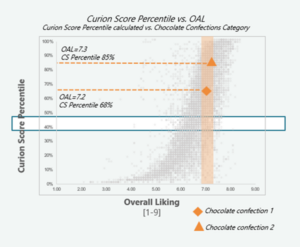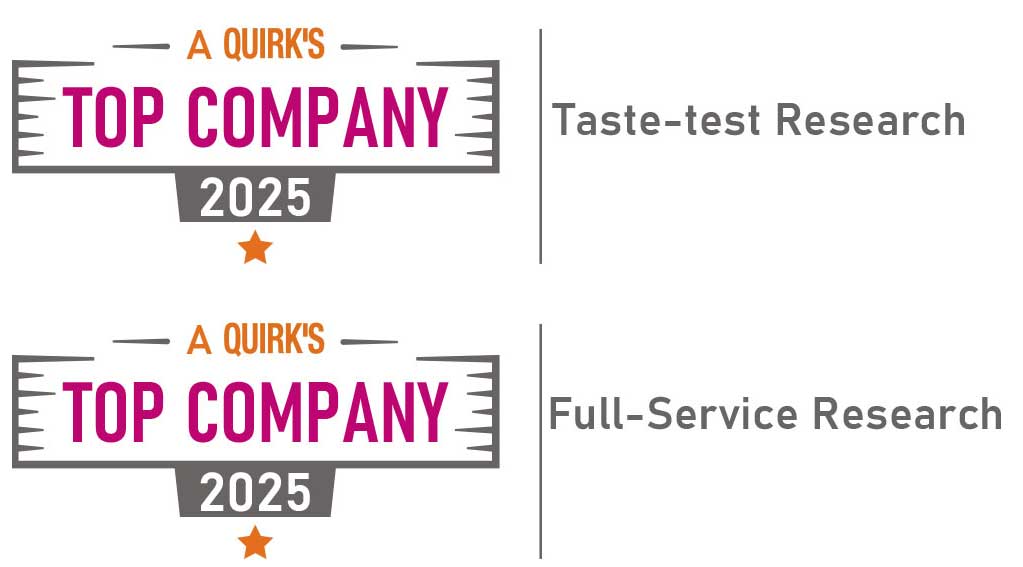Out With Overall Liking And In With A Superior Product Performance Benchmark
Authored by Patricia Manos and Michael Nestrud, PhD.
 1955 was a momentous year in scientific progress. The polio vaccine was made available, the first transistor radio was developed, and the first transatlantic telecommunications cable was laid. In Chicago, the first scientific publication on the scale we all know as “Overall Liking” was released by the U.S. Army and the University of Chicago. Seventy years later we know so much more about consumer decision making, psychology, and product performance, yet we’re still using the same scale, with the same limitations, for measuring product performance.
1955 was a momentous year in scientific progress. The polio vaccine was made available, the first transistor radio was developed, and the first transatlantic telecommunications cable was laid. In Chicago, the first scientific publication on the scale we all know as “Overall Liking” was released by the U.S. Army and the University of Chicago. Seventy years later we know so much more about consumer decision making, psychology, and product performance, yet we’re still using the same scale, with the same limitations, for measuring product performance.
In the world of consumer research, the industry has long relied on Overall Liking (OAL) as a standard metric for assessing product performance. However, there is a more nuanced method for evaluating products that allows brands to make more informed decisions and drive true innovation.
Enter the Curion Score™: the new industry standard for product performance understanding and benchmarking
Move Over OAL – A New Industry Action Standard Is Here
Traditional OAL scores have long been the industry norm, but they often fail to capture the full spectrum of product differentiation.
"In my entire career, I’ve only seen a handful of products score below a 5 or above an 8 in OAL. But with our scoring system, we’re now seeing a much broader range anywhere between 1 to 5 stars, bringing greater differentiation and giving our clients the insights they need to make more confident decisions."
Keren Novack, President of Curion
A more advanced product performance evaluation approach addresses these limitations by:
- Greater Differentiation – OAL scores tend to cluster within a narrow range, making it difficult to distinguish strong performers. A method that mitigates range compression provides a broader, more actionable spread of results.
- Enhanced Decision-Making – A high OAL score may suggest a product is “good,” but without a clear comparison to others in its category, the insight is limited. A structured scoring system offers that clarity.
- More Predictive of Success – While OAL measures general preference, a deeper evaluation of product attributes gives a stronger indication of market success, leading to better refinement and commercialization strategies.
- Breaking Through Category Biases – Since different categories naturally fall within distinct OAL ranges, direct benchmarking can be misleading. A dynamic scoring system ensures more accurate product comparisons across categories.
The Predictability Problem with Overall Liking (OAL)

One of the fundamental challenges with OAL is its inherent predictability. Historical data shows that any given product typically falls within a 3-point range on the 9-point scale, making OAL a relatively static measure. With extensive category-level data and experience, we can reliably estimate a product’s OAL within an even smaller range than this dependent upon the category, for example all ice creams typically fall between a 6.8-7.8.
If brands already expect most products within a given category will score within a narrow band (e.g., 6-8), then what value does OAL really provide?
This raises the critical question: why test at all if OAL simply confirms what we already expect?
The Issue of Range Compression
A key psychological bias affecting OAL is range compression. This phenomenon occurs when consumers hesitate to use the full scale of a rating system, clustering their responses within a limited range.
This happens for several reasons:
- Fear of Extremes: Consumers often avoid giving extreme ratings because they worry that a better or worse product may exist in the future. This reluctance prevents truly exceptional products from receiving a perfect score and discourages extremely poor ratings unless a product is truly unacceptable.
- Normalization of Experience: Most products that reach the market are designed to be acceptable or above average, meaning they naturally fall within a tighter range. Very few products score below a 5, as anything lower suggests outright consumer rejection, which is rare due to companies’ rigorous product development and testing processes.
- Psychological Anchoring: People tend to default to a comfortable middle-ground rating unless they have a strong emotional response. This means most OAL scores fall between 6 and 8, making meaningful differentiation between products difficult.
Because of these effects, OAL is compressed into a narrow practical range, limiting its ability to differentiate products effectively. Since different categories have different midpoints, shifts within the 6-8 range often depend more on category norms than true product performance.
Additionally, some categories naturally perform better than others, and this is not necessarily a reflection of product quality. For example, sugar-free chocolate generally receives lower OAL scores compared to conventional chocolate. However, this does not mean a sugar-free chocolate bar is necessarily an inferior product—it simply competes within a less-liked category. When evaluated against the broader chocolate category, its scores may seem lower, but within its subcategory of sugar-free chocolates, it may be a top performer. Curion Score™ allows for deeper product performance insights by benchmarking not only at the category level but also within subcategories, providing a more precise understanding of how products compete within their true competitive set.
Expanding the Scale and Driving Actionable Insights
 Unlike OAL, Curion Score™ helps “spread out the top end of the scale,” allowing for greater differentiation between products. This is crucial because product development and marketing teams need a metric that highlights meaningful distinctions, not just minor variations in overall appeal.
Unlike OAL, Curion Score™ helps “spread out the top end of the scale,” allowing for greater differentiation between products. This is crucial because product development and marketing teams need a metric that highlights meaningful distinctions, not just minor variations in overall appeal.
Consider a recent example in the RTD (ready-to-drink) beverage category. Two products achieved identical OAL scores, yet their Curion Score™ numbers differed by a staggering 40%. This discrepancy underscores how important it is to diver further into analysis to uncover deeper insights that OAL simply fails to capture. If brands had relied solely on OAL, they would have missed a critical performance variance, potentially leading to misguided product decisions.
Disrupting the Industry for the Better
The reliance on OAL as the industry’s go-to metric is outdated and fundamentally flawed. By shifting to a new method like Curion Score™, brands can unlock deeper, more actionable insights that drive product differentiation, innovation, and market success. The data is clear: OAL alone is not enough. It’s time for brands to embrace something new as the superior action standard for product performance.
Curion specializes in delivering impactful insights to the world’s top CPG companies, helping them develop winning, repeatedly purchased products. Curion’s deep data-driven product insights, sensory expertise, and state-of-the-art consumer centers enable them to uncover responses to critical client objectives. With over five decades of experience in the product testing industry, Curion is dedicated to guiding clients with their proprietary XP Xperience Performance platform, connecting brands to consumers at every step.
An innovator in the industry, Curion recently developed a groundbreaking benchmarking product testing method, the Curion Score™, which has become a trusted and sought after tool within the industry. As one of the largest product and consumer insights companies in the U.S., Curion has built a reputation for excellence and trust among the world’s leading consumer brands. Curion’s commitment to innovation and expertise, coupled with a passion for delivering actionable insights, makes Curion a valuable partner for companies looking to develop and launch successful products.
